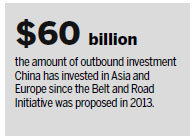An opportune time for closer Asia-Europe cooperation: new challenges and opportunities
Historically, the Eurasian landmass was the heartland of the world, giving birth to both Eastern and Western civilizations. As early as more than 2,000 years ago, our ancestors opened the ancient Silk Road straddling Asia and Europe, which became a bridge of exchanges between the people of the two continents. After the end of the Cold War, political leaders of Asia and Europe started to think about how to facilitate exchanges and cooperation across the continents, hence the birth of ASEM in 1996. Over the past 20-plus years, ASEM has deepened understanding and friendship and invigorated political dialogue, economic cooperation, and social and cultural exchanges between Asia and Europe.
The international landscape is undergoing complicated and profound changes, with rising uncertainties and destabilizing factors. Regional flashpoints have kept emerging, and nontraditional security threats remain severe. Although the world economy presents an upward momentum, economic globalization has met setbacks, and protectionism is rearing its head. Countries are facing a major choice between openness and isolation, moving forward and back sliding, and win-win cooperation and a zero-sum game. Such is the backdrop for the upcoming ASEM Summit.

Common challenges require closer cooperation. ASEM was established when the Cold War came to an end and economic globalization gathered pace. Multilateralism and an open world economy are its solid anchor and abiding commitment. Facing unilateralism and protectionism, ASEM members need to unite as one, translate challenges into opportunities, and meet difficulties head on, so as to usher in an even brighter future for cooperation.















